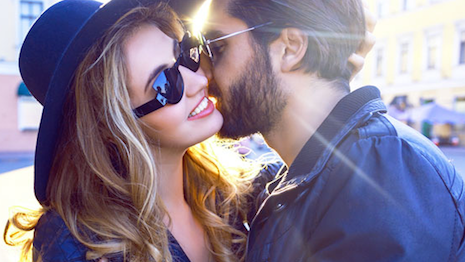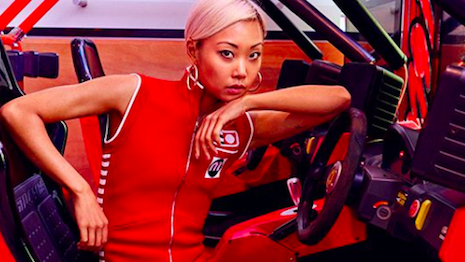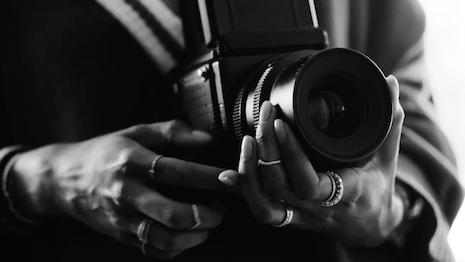VENICE, Italy – Influencers are a major new factor in the world of luxury, but luxury brands need to understand that the number of followers an influencer has is less important than the makeup of that audience.
At the Financial Times Business of Luxury Summit on May 22, fashion model turned fashion editor Giovanna Battaglia Engelbert spoke with FT’s Lionel Barber about the origin of influencers in fashion and how brands can do their best to harness the power of these social media personalities. What was clear is that brands first must understand their audience before picking the right influencer to work with.
"I think you should know your audience," Ms. Battaglia Engelbert said. "You don’t need to hire the influencer with the most millions of followers.
"You could hire someone with 5 million followers but they might not be the right fit for the audience you want," she said.
Influencer marketing
For many brands today, influencers are the most exciting new prospect in business.
Influencers amass huge and dedicated followings, which can be fruitfully used by marketers to target and engage with customers on a deeper level.
Ms. Battaglia Engelbert emphasized the “dedicated” aspect of an influencer’s following, rather than size. Influencers with smaller but more focused followings are more useful to brands than influencers with large but indistinct audiences.

Modalist's has a tool that helps brands get more value from influencers. Image credit: Modalist
As new as some of the influencer models may seem, the core idea behind influencer marketing is a fundamental part of the luxury business.
"Fashion is always about influencers and it's inspirational," Ms. Battaglia Engelbert said. "Coco Chanel was a proto-influencer because she inspired people to dress like her.
"Chanel is still a incredible brand," she said. "They’re disruptive just because they are not. Everyone is being so destructive and they are just Chanel."
Ms. Battaglia Engelbert also discussed the platforms that influencers work on, namely Instagram. When asked what platform will succeed Instagram if it goes out of style, she said that she did not know what it will be, but that when it comes, brands must be ready to jump on it as soon as possible.
Big ideas
Just because luxury goods are expensive does not mean that marketing them has to be.
Ms. Battaglia Engelbert spoke emphatically on how brands can create high-quality, engaging advertising on a smaller budget.
The key, she said, is ensuring that the idea behind the campaign is strong.
"Ideas come first, always," Ms. Battaglia Engelbert said. "You have to have a big idea and it has to be a genuine idea with great content and then you decorate it and make it more photogenic.
"Something plain will not deliver the message," she said.

Brands are driving influencer marketing growth with bigger budgets. Image credit: MyTheresa
Seventy-eight percent of marketers working in fashion, luxury and beauty report leveraging influencer campaigns, marking a 13 percent increase in the past year.
According to a report from Launchmetrics, brands are also investing more heavily in this tactic, with 60 percent of marketers expecting their budgets for influencer efforts to grow in 2018. With millennial and Generation Z consumers driving much of luxury’s growth today, influencer marketing has become a key component of marketers’ outreach to these digitally-native individuals (see story).
"My advice would be use word-of-mouth because it's free," Ms. Battaglia Engelbert said. "Self-generated content is the best publicity always.
"That comes if you have a good idea and if you do outreach to the younger generation," she said.
{"ct":"oNPgdr6oXrXzGX0xVvt+G3hJ\/epMPhcQApK6cg\/3PKLszUpKNcZ1+1z25YVvq5T0KPMAhaUNSSlUC+StRAwdCksE+yjihg8Nk504dRFL23kxbXQddEBOP9W0PiVKtO8zepAALGBNdagEdu9rfLcnk6Trpw9SwD7X4SDky++K8N0T61Awr3WTLxO6jTYLeoP3DI74YHEzn6SlYZLv0IcjmluKFzs\/G8YflhYlMdj+EhaYwG1xl958wU3P3hpzusAoDC8eXT06+H7dl2iLWuwFIjdNk9nwmxS8A1IP7976ayXmpflkuGRL+AIN\/8UUwrMdwVYm7\/Bp6PI2eCcXVQxq0R0tsFNBbp2mJr6VPVN1qDo9OgxYEqd0iXEd3ublUXgjch\/1KVLVCiWSX17R0YiDIFNAKtMU73IkDEHuYuoolJjjbhNC+aDJ+ub2t2B5o2S4CdBQ94n8kMhGxMGtsWa309bSLKdw9RD01ZeZlYRxsFWDTlxRerwu\/voG0jfg6+589c56vmc6BSvaFuOGOjzoDS9QMQ8lgODgLCZXznnFmX0PmSKvFjRffnfiptCdwNW8ktkawtR+Tos9sv\/R\/WP3fcPGwUoSGrNqU7JMQIosQrK91QQRWhDYKt2dZUz5Unc9m77GfmVkB+AtQntZC5rkGsakpCo4c6Udj5KntcF3bXurjzJW3p10t35vLpmrD57vcxTvzl6ZJ7VJIb\/FAmHOTvHlLkPy7Cl7FuK96NVtpZKAX5dJpGwTtk0sQMKfV+KrnEREE78PRXlLPy1pOhpbc8ALKHbWYA8VkaYeEkBYR3nFn\/RWTCHoo2U85Y5gEqZS3wchL2io97tBS3mPsME1pg4Y4mR2ETMMSy7szxLJ8Dt0QQTMW+Zk1sYPLmKFZVUXxTGDoQ2qDuPArpstXNyaFcrmVjlIoOa5CghswQB4FaJaX6W5+WaJ+f4g0x2EXws\/9h3XofGc3QTifhGFycfscanDoR1D1RWdQio8EAlKXJFEvxqZ2LHAmmzqRkx53IREZCKwKv0n1ceXK627URk45rHfmj9L5nwmTac6wWYw3DC+e090mJUIISM5z\/JvvahAsbxnHx65yU+wPFczHmxtWBxx\/OSy2rWZofm4araLi4fFa7f5xgCLLkD\/35mU0\/KYwCOKE6WWvjTE+zNFjJ7pDrbv4xnJXGfMy4fYevICggEn7pW06FPE7AKSpkvpS33I4hcLcp3YplQDL7GezFKEOJ0wB56Cuz\/jNl0c3ehRTJRbGZwUCObF6fsZJ+HayElkBobMAAA+rDsQpO20efaaStFTOQQSnPh7l6niQsINppobYllU1\/XYL29QqNB9mPM9MgFPgBLi01U5nJspHxcVoSW98OndmrmIGSNU386Jr2kY+PiKF1D7n\/S+vunDE8M9kGD2Lv4R\/SAgpaaJBK2V5aY\/d5Lgnmih\/1147fNBKroLm41eGBF1aiGCFUpUhDvwaDU8v37DiVqtFrGPlLtf4JOn0+u\/JlEm7yU+bHCJekcrvEBoSZlrvh+\/3QK5Pu32l1HuLBgJnM8uIV1eaf8LvmaSIdxiY3A+HXBifJwF5TiPCeaIoOFdZN\/hB1CFSDwScDZTfrTehlNfNbW02R+6nSx91UK+F7SvMtrHIlNUkBDULA6Wz7wEoWfe1Wz3+no3\/8Jg55PStN+4R4+grbcz\/P40QvZapZdNYk2t49\/lvds6oWpEBq\/QwssyQrfLQ4UGNEVRa5jqkN9NFYbRhlcYB\/S5DybnjXo9X5KEsTivJZ+qwbkFbD1Bty8EId\/nO1y3sCoqfHyaVxQGtrb4UfmbnOGVuQ+6fPk\/\/fTzvfxGlduNaH\/CIP4U1sW3Fj2Kq7Heg1fWONTJW325OeJy+mIx3PYmumEEAQQQgZ4N+Uf2cE8l7hNnFtyZFOOLVnqjSP7jQq6tUUbKuUoh7xcb0UHruOUB5VKyoemUV8Pp3JB1IiPU9p8cJw9uTtGaHiPdFIT0TiLc89K\/aiPmbefe8cJeY+IjBG8+d9XCAe6jw1ln2MheHiglUnj+P2FWRNpmNCxM6l+988qdSi3tcaEF\/pGldFo94AfdHpVpKmPNb6f+sB0OH9DJlFbTPJeR820ha4DdUAGkkXn7kiTKHIw0vdccWD9T9r2aiyfn757A3x6JVaTi8Sq8+Ydduu3dUAoQGENTO+H58Ef3bFdQc6FheqR5NZFiYknGj4ekPvxtGP4sfejwhlcmlQQpFTy+5kGQLJtxX4KRYSBW+dXhQT+GOg0HR5TswX5QRq5jN2gwm8DulLMh\/4vjVHfr\/gMosXDKGZypCRPclFoD6cPCEhl3uXXx\/AaXJXviV2ed01i2tWLHJa8DdrgBa50eSdp8Ipq3sGuusblQNrbJkZiQ1W3Z5ivG5oMoGwNX1CbLRNYVxtdt5MsywBf3Re7qtAQ\/A\/j6tFk0ALtkPlKPbVJ1XuwVMwq4bdSAWDaQoV6sS7mVEx9KOQQZXaMuqytuqQ56fNKCP0tMwoSC2P5APb4KhCb8FVlpqAe1eb1URN9HxxcXOCG8FZyG7AoYHbAZTzSkhul+OHDt2vDhsxumoTa+aYhY3KmZsULjzw5Wp8NRhOjG2A7liSX5k0C9EuFlbcGbUnBYL9hYwc6Muo7ieilqQfonzrHBiV+9ODezfxmDXL6MMEDhIg+1wD+8hvR5kqfB1lrFD1tqhkY5Zjyq8PflKOsOtLt4VrCsI8LUWxlDNEIUXu8l09zGtCcgnJgvYLIxP+IGIRcyaF91MrBkB3N4Oxab4ibRUaFo\/5HHzdZ+oIdbzt8w1qYuxA3WqRVJVJF2jnBXSEGWTAHeMpJsMnR1SqnDWx6K8RiDcSWIdHT8JsqYkwEp3z6uMrvePE2iFKYe+arPy9Gild3o0jXRv2ZgxtBXIT5oJE59LeVry5vz\/XA9dHi4s90bdLxEDgq5hoks5sh24DXUpMcsWPy58WnZ6W50GEyZy+t8ziLs9UWJ5khBeU1ttfbdgcVzNaLtWGFikOIGKVTmNkedzv+Q4PbdB0BLV0c3u394wmoG67Z+APOqenuEnUo3y9YxkqS\/180EwBTjs7O9dU0wP72\/JwvsJIfUwzYaRmlsNKij3RvP+CGwxqHtKikHiUzJ6caVsYVekuifN28eCT2ZgpSx0XNeQPLnBue40KZkcEoOLlYmoTgXdsFr+V4vcP2Zr5oMqYTVOBhEbe5h0bKQSa6c1DDhT+HHx1ZWZPZFVx\/9xFYVKtfOY9TY+f08PJIGnnrogynnfXGd1IeAjT2EWhmBEteO9SxN+2rJaTW2eqDVYzFwQdXCU0ZccW5\/i3y2IOLzsoHkzVGzYw7ICsLQLgWsEjIB206eYhBSyCaV9CIoMx9TpDhnsb6sSvXgtVY3DHkk4L4265y2+9Qy+ZXb6Ui79rkATdikfEzuaI5m0rOWMQgTv7IrDI5h0MlXjmvz58fnYbSmFyUu\/ynYOHmZQkcHQHGjHsk1gQVBz84uo59ram\/\/Mf6Lvo\/5yW2q\/r1Z0x9cRHtANbomqhP+dSBHZ55pztuxKfj\/KPCUbxjA8jPyhkQ+GOScXyO+qkFNveMf5i+grmqu6PD9czQXe81Lh6BPnFphRNF10WZ7R3pLpm7hjoJnsX+O25s88mIy2obnvo0cGXCGfqrqIoLGZbSj4pam\/lB17yJdxPvX2ThR1s7GvAFmSkza7a4vZqzjSF3OKLcW4mhQyL9h5cowXnuLpsXpyVgJ\/9iSODuYhun8G8uycN9gq\/D\/KLw8MNQp7JGqW+ZEMo1tsiQa17bZut4bihbLJFHIDkDyXNnzesAMv6bqhVPMxc1Ks1QLzdpE0fsfGV5u+1k1\/dNBMYjIKls17fjPoHXEE5fxAnkMvSt5XGyrqH\/q98q0oKrlHOrLfIj6pF1LKDkEr8bRRWgplytvdNCRGk1gY62y8byedJUETvgzJ2vYbg1pHFrKkLlH\/FguWxvH\/GcRoP3CJTRbs+EArR8UZ7mg0+kZnp31rdX\/etPje5RhO098HIXGGV3PVayZ0diUOYOmmaV6PHZ7ypVQ7m7PJYv6xgut1giStL\/qXedKtdxdi5fWv+KIgmEjMSu0dfBOcnuah907zc\/zTMTVQQaLISJzqt0j5gQTbB5lxzh\/9+exvaSORZM4nglxjGs6GQcdCzPNxeVZGRCSo6qP4KUjG0YDeGd3S8zpPb1lS4Lau5v9CQnjuqN32tjNf4QpBJFIz04M3dQFS0JzPC2jUGashmgxTyo5dY6ky86B+2\/Urenrnf5AWW91ZqzOSAhxKsQHoMn5NnwHgvMPUOw47ZVbmRLdhVt4ZioQ0g7BfkiM+aFKgmBf7S5T173j\/ZPwgr2qVyf27pDDSqxN5j10iptNm6+n2rss7AfN8AybnRvWzuxl8GQTWbi2oveSGAQ0\/FBVUfhs7r0UAGIRktzgAgwujuQl3snxAnJO4w2JTQHbUTyinXejCKYNC7Sr1YuhjimHmv4JI9guMA2DGYJxlwpvLcBErL2yCNVhFcmLSnuU9cMXhWC2cVzepGYYFb4Rc\/i22xYQAlds2oJwW5tz9lSWFm0kZNUt3Z\/TJbmul9Z+oevKV1hANFhzKcK0UkEfk8sEr9B5oAiTFHIK3jskqTgn41Wr4t3EaG0r2uCw1ahiC+75sipZCvmGEttw\/2z\/4E\/jUAtQqfcAk76hYNnb\/ZfYB5TZv\/lSyNYt7+dsdB6DWghwmUal9FZ+mjSFfh\/h3IlcobkibtoyNrDofW6Hv0\/BVfHTRFJts7KJbjY3pQCqmODd336s\/EkPmKvoVNrR9SoK5jCJdRX+RFxsH4uYllpo6W0I6eEMlKKhNTX2QHAyhoJnvXnDaDlRfHH3r+GQ1Qm3DA7QaL5wohA7906P26sQaa7nBtqkITt9Gu4R2v+6xNg7KKhixu32iEFYY\/ggevTy4CUuB7KHNbQkM1fmgTRjcnXg10BGOtKbyjKWrlKmoHhbr+lxPvDEFceHtGRpgV3mnv8YIU6JEPKmpybGzLznAlv0\/fMJCt+Xp0HKH3Mgr9bzFvhx0T73FmLpahT11VsVuAB64up2WTuCGyCB2vATNN2CbQQblGnpbn+iFXg5BC7fDZazILI1pkStr9WJv240HFhVI5h\/H4iZTa0d5I3TruU8yTb6mbEbjGZJa1Gy4NB\/yW+Akq3aqwZ6U75vg3V1PsNL+cIkMPLB9HrE1B0DNzumNVV6oOJ6DLupYuT1jP+m9FG5H2KzgOyKr81BzCyX0hsYepssTI2enV0t0qAr2RKlKa4rASZn2dn9YV19kP8+3YJMDAN6XtUsFr5K92QcQbDrMWXYhHvLh2xuXIXi3n7AqECWc+aPw\/pSjphM8CsEBlkDi9Extoi3uUmVlA5D28uyFuLby1z5Tsx\/SUf0VgSARBA7jADzRGYVJ7KhTSGtotcARNwPKZCdeG4\/8bmH1GD6qAEkXZXi3ZwAicIEn+olVI8Zmi147bx2n0zqSqYAO7PyqfXP5N6tBi+PqUfcZOOQ3eg6h+OpAAcGuYSCYamluLkJlSg35ZZOv88T7zJjG92vaAJ2X\/HnLxpdD+JmeBC5fqSFqFeY2h2MLW559TPmZjPEJGlK8Ln8QrdkfgbooZXN\/0bXJBhk\/HgE0LtSqQHqxa4HVY5tw3ysgtV7tM1KajD2tpswN+DucgF2l2sQoGaK5XJeGeHPqFzK\/oO1wicYZA6Q+UbJEs\/mU4oEoUUgoBCqqpJ631BCuuFyT\/pXyhz1jw6spr0MNYeLbaQNZUAZXolxuzIfQbTtwVfliPhKxdpo8cZgAwjWaZX14\/bKn+8vaY1utWfcAaAKZ53oaih0KOuXJk60D7GygWKAgx9IQg7\/5gBqgabX8hOkNpO+UYJIW9\/Ijj8ZBQnaSNVbNM+SGpyiE9XU78xprmPHSEDMGI+vUh0SBMTlvbNR2mxehzR7SiMi3eQzMBa\/0D5ParR2fMKTT1ftcyo4amZ7F\/R8p+ulutBqzCGDRmSGSWCEoHHGLmofeo1XO1ozZSpyXNDfDfImfqq\/2ngZBaInVJ8zC8lwkc4kHCPx1RnHaQyOxy\/dYWj6t6A0QnxKBWU76Ic6V6EUCadm4ffnWoAJC\/acC1GlH0afhEL1A7NTq9saARwxkO063zunAJOmzsXplap5zCWCgp2YRuIy211Pc7kYVT0aIitV8OZ4Ia\/5YAVMQsMQVBZwo4xWnHrBJJsE1PMeWHjPC1AMuIROn3GDtAzPMhNto5fV6bQS9XpC2YnAV1oSsHftCjUON7xHDJ5R0RHCdg8Xaf6WP7WKVcFngqKs+3j5PTB+X\/WMNKLSa7yaJX8wpZ5Ei29rY1KTJtLNjmUgQer\/tVAgV5KiOG5FeMMr9YD8Q8gmFduhDicXvQYYsour+Qxv7WtKRDC1rYasztKX3HqwwgftycXadmKdczOf9GxXKfAK2zAvyRWng7bcNHPrrUbf5R3oIFvAmJAo22GTLDOV2cL7CPy3X1Xc7MbnqkIe2\/Rx0+kL8h6gphoF1WABky7BOv0F9AD21zq0UvSZEgiIagTw6\/+XyoPMjIpIt7bsw1iq7Ktycswi9Z2E5ZBBZxL60Z8=","iv":"6dda1b40e8fd55408cd20160e456f69d","s":"ec197bb48f18a279"}

 Brands like Tiffany & Co. have made extensive use of influencers. Image credit: Tiffany & Co.
Brands like Tiffany & Co. have made extensive use of influencers. Image credit: Tiffany & Co.